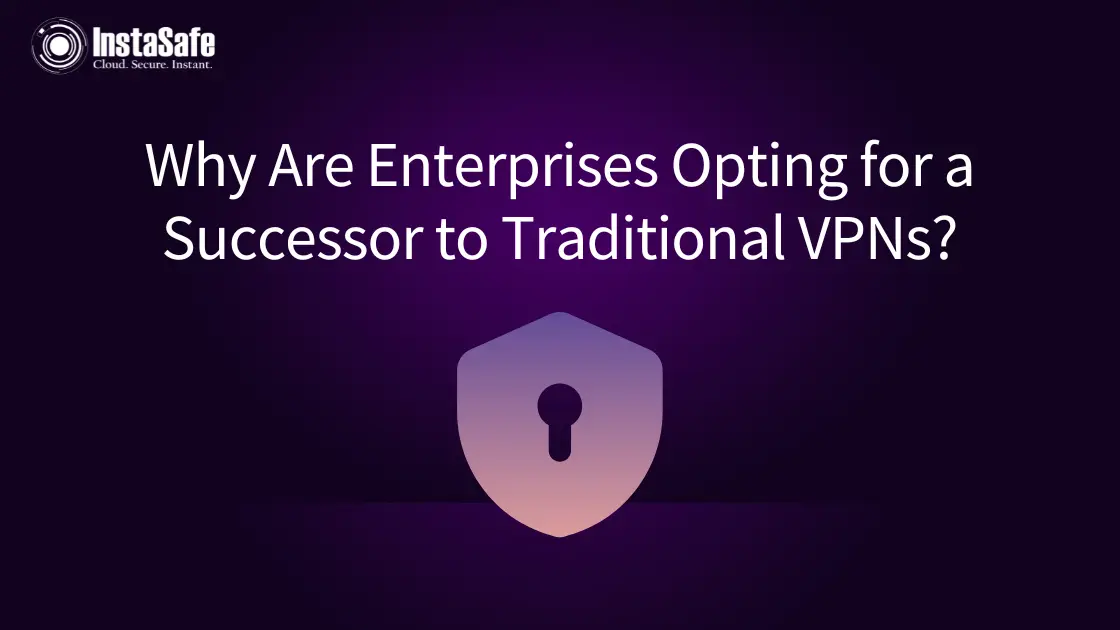Why Are Enterprises Opting for a Successor to Traditional VPNs?

The pandemic ushered in remote working, and VPNs became a necessity for most organizations. For years and years, companies have used VPNs to make secure connections. Despite its functionalities, hackers have managed to gain access to VPN's vulnerabilities and converted them into a weapon of cyber destruction.
Virtual Private Networks, or VPNs in short, have failed to live up to people's expectations. It's obsolete, and its responsibilities of masking your connection have failed miserably. Its shortcomings, complexity, and false hopes of security exacerbate the current IT security risks.

VPNs were relied upon heavily at a point in time; however, times have changed, and there is a paradigm shift in the way security is perceived today.
Enterprises have decided to move away from the traditional connection model; here are some reasons that make the whole process more pronounced.
VPN Are Not Built for Continuous Use
Remote access VPN can't connect the whole enterprise to the WAN. Idyllically, remote connection services can connect only a handful of workers over a short period. As large-scale remote working has become the new norm, existing VPN infrastructure can't bear such a heavy workload. This is promoting an environment with negative performance and user experience.
Management Complexity
VPNs require an agent installation on end-user systems and devices. Such end-user devices can range from personal devices like tablets and mobile phones to laptops and computers. Each personal device connecting to an organizational network needs access to corporate apps and data, which can't be managed through an MDM solution.
End-user devices employ different types of OS systems, ranging from Windows to Linux to MacOS. A traditional VPN service is challenging to install, costly, and difficult to manage remotely.
Increased Attack Surfaces
A VPN security model is an ideal example of a castle-and-moat security structure. A VPN tunnel gives access to the entire corporate network, even when the end-users only need access to a specific subset of applications.
The higher the number of applications, the higher the exposure to threats and attacks. This shows how insecure an Enterprise VPN service model is and how it exposes the entire corporate network to breaches.
A castle-and-moat structure also increases the chances of a malware attack on the corporate applications, leading to excess data breaches. To add granular security to remote VPN applications, organizations must deploy additional security solutions, which translate into extra costs and increased human efforts.
Unpredictable Performance
Let's face it; VPN connections host over a public Internet connection. This means the public Internet performance directly impacts network performance. Packet and jitter loss are common in such connections, wreaking havoc on critical apps and even user experience.
MNCs, which have a global footprint, understand the latency in sending and receiving network packets all across the globe via VPN tunnels. Let's face it; even if you deploy additional overhead VPN tunnelling, the latency is here to stay and will continue to worsen over time, as more users are added to the existing network channels.
Unreliable availability
Enterprises depending on public Internet can't be guaranteed availability for remote access whenever they want. In outages, there is a direct impact on the network, which results in lost productivity, idle workforce, data and other eventful security losses. The risk of such losses outweighs any benefits that the use of public connections may provide.
Trudging Towards Better Alternatives
VPN is resting in its crypt; one can't define the timelines for the final nail in its remote coffin. Given VPN's restrictions and the evolving security needs of enterprises, there is an urgent need to look for alternatives to facilitate remote working.
The most evident heir to the security throne is Zero Trust Network Access (ZTNA).
As a network service, Zero Trust is secure and offers direct, managed connections to limited users. Additionally, it provides granular micro-segmentation through an encrypted pathway. It's like getting access to a single safe deposit box, with secured access for the authorized owner only.
Secondly, ZTNA is deployed in the cloud, which transitions your security off-premise right into the cloud. This ensures inline visibility so that remote users are not routed forcibly through your enterprise's data center. By following this route, organizations can facilitate more accessible access to corporate applications.
Zero Trust is an expensive option; alternatively, it does not require multiple resources like time, effort, and capital expenditure to keep it going. Considering all these factors, ZTNA is here to eat VPN's lunch and become its successor effectively.
VPN is Being Replaced, and ZTNA Is Not the Only Option
Software-Defined Perimeter
Another helpful alternative to VPN is Software Defined Perimeter or SDP. Just like ZTNA, it incorporates a need-to-know access model. The system is well-equipped to hide critical infrastructure in a metaphorical 'black cloud' so that files become inaccessible to regular users.
This is not all, for some of the other parts of the network are accessed only via permission. One-time users can only access the data at a basic level. Users with regular access can access the network at a much deeper level. Security levels are enhanced and focused on protecting the local network.
Identity and Access Management (IAM)
IAM, as a platform, provides enhanced protections for a VPN, as it doesn't require a username and password. Instead, the model incorporates a series of verification processes before the end-users can sign on.
If it's impossible to replace VPN connections, you can utilize multi-factor authentication on top of your VPN connections and integrate it with your vendor's IAM solution. By enabling this methodology, the session activity of each user is connected, and network managers can keep track of who's accessing the networks.
Users with access privileges can connect to the network, making it a comprehensive connection model. While this model might be a top-up for your VPN connection, it won't secure your server or domain administrators, as IAM's functionality is somewhat limited.
Conclusion
Enterprise VPN services will soon become history, as newer, better and fruitful security models take over gradually. Organizations are beginning to understand VPN’s limitations, and they are moving towards a more secure model for remote workers.
Companies like InstaSafe provide a series of useful products, which keep VPN’s limitations in mind, and further build on their strengths to keep remote workers safe. Do have a look at their services, especially if remote working is a new norm within your organization.
Key Products
Zero Trust Application Access | Zero Trust Network Access | Multi Factor Authentication | IAM Identity And Access Management | Secure Enterprise Browser
Key Features
SSO Single Sign On | Endpoint Security | Contextual Based Access Controls | Always On VPN Connection |Clientless VPN | Device Binding | Device Posture Check | Domain Joining
Key Solutions
VPN Alternative Technology | Secure Remote Access Solutions | Cloud Application Security | DevOps Security | VoIP Security Solutions
